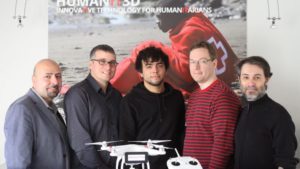
HumanITas Solutions, a Quebec-based collective dedicated to a “collaborative, evidence based, field-tested and affordable solution aiming to enhance humanitarian response,” has developed a distributed, multi-drone management information system that can provide smart-phone driven UAV solutions in “low-resources environments” [i.e. during a disaster or conflict]. Nimble response times allow teams to get quality, real-time data during emergency analysis.
Dubbed Humanit3D, the “mobile ecosystem” can integrate secure databases, workflows, messaging, real-time 3D mapping and artificial intelligence capabilities during an emergency.
“A smartphone is used as the computing unit and a WIFI extender and is integrated directly on each UAV,” a group spokesperson explained in a statement. “The smartphones are connected through a flying mesh network that allows real-time collaboration between UAVs, thereby providing an affordable ecosystem for automated drone management and swarming, which may be used for humanitarian work.”
The ecosystem can not only enmesh drones into a smart swarm but may include sensors or other compatible “Internet-of-Things” devices.
“Swarming allows a large collection of aerial UAVs working together intelligently for an efficient emergency response,” the group stated in a release. “Using configurable protocols, UAV communicate with one another on the fly to automate and enhance their operations.”
Humanit3D is one of 20 semi-finalists for the annual Drones for Good Award – a competition “dedicated to transforming these exciting [UAV] technologies into practical solutions for improving people’s lives today.” A total of 1,017 projects were submitted from 165 countries. The 20 semi-finalists come from the UAE, Canada, Australia, Ethiopia, the U.S., UK, and the Philippines.
DRONELIFE readers will no doubt recall the many ways in which drones are being used for humanitarian purposes.
- Austrian military drone manufacturer Schiebel has teamed up with refugee rescue organization Migrant Offshore Aid Station to rescue more than 8,800 refugees stranded in the Mediterranean using the Camcopter S-100 for humanitarian purposes.
- University of Illinois Urbana-Champaign researcher Naira Hovakimyan recently earned a $1.5 million grant from the National Science Foundation to fund the development of autonomous drones that can assist the elderly with daily tasks.
- UAV Network founder Patrick Meier has developed new UAV tech for humanitarian aid, most recently utilizing aerial imaging to create amazing 3D maps of regions devastated by the Ghorka Earthquake in Nepal.
Jason is a longstanding contributor to DroneLife with an avid interest in all things tech. He focuses on anti-drone technologies and the public safety sector; police, fire, and search and rescue.
Beginning his career as a journalist in 1996, Jason has since written and edited thousands of engaging news articles, blog posts, press releases and online content.
Email Jason
TWITTER:@JasonPReagan
Subscribe to DroneLife here.